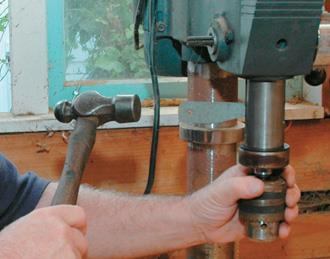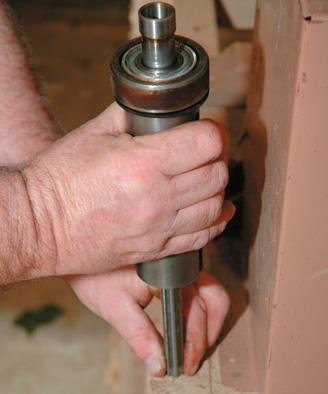If you’ve ever wondered why your drill press wobbles, you’re in the right place! We’ve got the answers for you. So, let’s dive in and unravel the mystery behind this common issue. You might be surprised at what you learn!
Now, imagine this: you’re all set to work on a cool project, and you fire up your trusty drill press. But instead of precision and stability, you notice an annoying wobbling motion. Frustrating, right? Don’t worry, we’ve got the scoop on why it’s happening and what you can do to fix it.
So, let’s strap on our tool belts and get ready to solve the mystery of the wobbly drill press. By the end of this article, you’ll be equipped with the knowledge to tackle this issue like a pro! Let’s get started, shall we?
Is your drill press wobbling? Discover the common reasons behind this issue and how to fix it. A drill press may wobble due to an unbalanced or worn-out chuck, an improperly tightened spindle, or a misaligned table. To address this, ensure the chuck is secure, tighten the spindle, and adjust the table alignment. Regular maintenance and proper usage can prevent wobbling in the future. Keep your drill press stable for accurate drilling!

Why Does My Drill Press Wobble? – The Complete Guide
Drill presses are essential tools for precision drilling in woodworking and metalworking projects. However, it can be frustrating when your drill press starts to wobble during operation. Not only does it affect the accuracy of your drilling, but it also poses safety risks. In this comprehensive guide, we will explore the reasons behind drill press wobbling and provide you with practical solutions to fix and prevent this issue. Whether you are a seasoned DIY enthusiast or a beginner, this guide will equip you with the knowledge to keep your drill press running smoothly.
Common Causes of Drill Press Wobbling
There are several factors that can contribute to your drill press wobbling. Understanding these causes is crucial in identifying the root of the problem and implementing the appropriate solution. Below are the most common reasons for drill press wobbling:
1. Loose Belt Tension
One of the primary causes of drill press wobbling is a loose belt tension. Over time, the belt that connects the motor to the pulley can stretch or become worn, leading to a lack of sufficient tension. This causes the spindle to move out of alignment, resulting in wobbling during operation. To fix this issue, you need to adjust the belt tension by either tightening or replacing the belt.
Another potential cause of wobbling related to the belt is the misalignment between the motor pulley and the spindle pulley. Ensure that both pulleys are properly aligned, and the belt is running smoothly without any obstructions.
Regular maintenance and periodic checks of the belt tension can prevent wobbling issues caused by loose belts.
2. Faulty Bearings
The bearings in your drill press play a vital role in maintaining the smooth rotation of the spindle. If the bearings become worn out or damaged, they can cause the spindle to wobble. This is often accompanied by unusual noises or vibration during operation. To fix this issue, you will need to replace the faulty bearings.
When selecting replacement bearings, ensure that they are of high quality and suitable for your drill press model. It is recommended to consult the manufacturer’s guidelines or seek professional advice to ensure compatibility.
Regular lubrication of the bearings can help extend their lifespan and prevent wobbling due to bearing wear.
3. Uneven or Damaged Table Surface
If the surface of your drill press table is uneven or damaged, it can cause instability and wobbling. Irregularities in the table surface can create instability when securing workpieces, leading to vibrations during drilling. Additionally, dents or scratches on the table can affect the smooth movement of the workpiece, causing wobbling.
To address this issue, carefully inspect the surface of your drill press table and make any necessary repairs or replacements. Sanding or leveling the table can help create a flat and even surface, ensuring stability during drilling operations.
Using a sacrificial workpiece or a secondary surface, such as a plywood sheet, can also help minimize wobbling by providing additional support and stability.
4. Improper Drill Bit Installation
Incorrect installation of the drill bit can also be a cause of wobbling. If the drill bit is not securely tightened in the chuck, it can become loose during operation and result in wobbling. Additionally, using a damaged or worn-out drill bit can also lead to instability and vibration.
Always ensure that the drill bit is properly inserted and tightened in the chuck. Check for any damages or signs of wear on the drill bit before use, and replace it if necessary. Using high-quality drill bits specifically designed for your drill press can help prevent wobbling issues caused by improper drill bit installation.
Regularly inspecting and maintaining the chuck mechanism will also contribute to stable and wobble-free drilling.
Key Takeaways: Why Does My Drill Press Wobble?
- A drill press may wobble due to an unbalanced or damaged drill bit.
- Loose belts or pulleys can also cause wobbling in a drill press.
- A loose spindle or chuck may result in wobbling during operation.
- Poor alignment of the drill press table can lead to wobbling.
- Using excessive force or incorrect drilling techniques can cause wobbling.
Frequently Asked Questions
Welcome to our FAQ section, where we address common concerns about drill press wobbling issues. Read on to find answers to your questions and learn how to troubleshoot this problem.
1. What could be causing my drill press to wobble?
There are a few factors that can contribute to your drill press wobbling. One common cause is an imbalance in the pulley or motor assembly. If the weight is not distributed evenly, it can lead to vibrations and wobbling. Another possible reason is a bent drill bit or chuck, which can result in uneven spinning and cause the drill press to wobble. Finally, an unstable or uneven work surface can also be a culprit. Make sure your drill press is set up on a sturdy and level workbench or stand.
To identify the specific cause of the wobbling, start by checking the pulley assembly and ensuring it is properly balanced. Inspect the drill bit and chuck for any signs of damage and replace if necessary. Lastly, check the stability of your work surface and make adjustments as needed. By addressing these potential issues, you can often eliminate the wobbling problem.
2. How can I fix a wobbling drill press?
If your drill press is experiencing wobbling, there are a few steps you can take to fix the issue. First, ensure that the drill press is properly secured to a stable work surface. If it is not, adjust the bolts or clamps to secure it firmly. Next, check the pulley assembly for any imbalances and make adjustments to redistribute the weight evenly. You may need to adjust or replace the pulleys to eliminate wobbling caused by imbalance.
If the wobbling persists, inspect the drill bit and chuck for any damage or defects. Be sure to use a straight and undamaged drill bit, and make sure the chuck is tightened securely. If needed, replace the drill bit or chuck to eliminate wobbling caused by a bent or faulty component. Lastly, always ensure that the workpiece is properly secured and supported during drilling to avoid any additional wobbling.
3. Is it normal for a drill press to have some wobbling?
While some minimal vibrations are common in a drill press, excessive wobbling is not normal and should be addressed. A properly functioning drill press should have minimal runout or wobble. Excessive wobbling can affect the accuracy of your drilling and may indicate underlying issues with the machine.
If you notice significant wobbling, it is important to investigate and resolve the issue. Start with the troubleshooting steps mentioned earlier and if the problem persists, consider seeking professional assistance or contacting the manufacturer for further guidance.
4. Can using the wrong drill bit cause wobbling?
Yes, using the wrong drill bit can contribute to wobbling. If the drill bit is bent or not properly centered, it can cause uneven spinning and result in the drill press wobbling during operation. It is important to ensure that you are using the correct drill bit for the material you are drilling and that it is in good condition. A straight and undamaged drill bit will help minimize wobbling and improve the overall performance of your drill press.
If you suspect that the drill bit is causing the wobbling, try using a different bit to see if the problem persists. If the wobbling stops with a different drill bit, then you know it’s time to replace the bent or damaged one.
5. Could an unlevel work surface be the reason for drill press wobbling?
Yes, an unlevel work surface can contribute to drill press wobbling. It is essential to set up your drill press on a sturdy and leveled workbench or stand. Uneven surfaces can cause the drill press to tilt or shift, resulting in wobbling during operation. Use a level to ensure that your work surface is flat, and make any necessary adjustments to achieve stability.
If you are working on a particularly uneven surface and cannot achieve stability, consider using shims or leveling feet to compensate for the irregularities. By establishing a stable and level work surface, you can help eliminate wobbling and promote accurate drilling.

Summary
If your drill press wobbles, it’s important to check a few things. First, make sure the table is level and secure. Then, check the chuck for any damage or loose parts. Finally, examine the belt and pulleys for any signs of wear or misalignment. By addressing these issues, you can ensure a stable and reliable drill press for all your projects.
Remember, having a wobbly drill press can affect the accuracy and safety of your work. It’s always best to address the problem promptly to avoid any potential issues. So, take the time to check and fix any problems you may find, and happy drilling!
